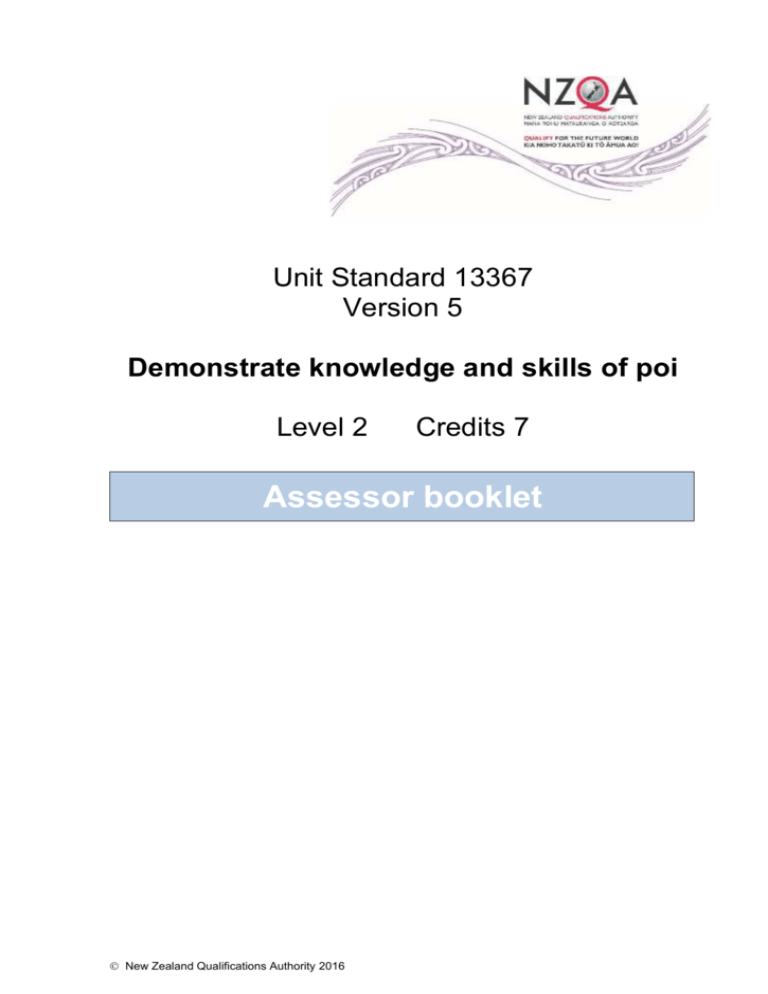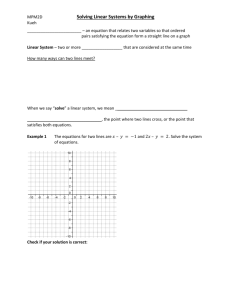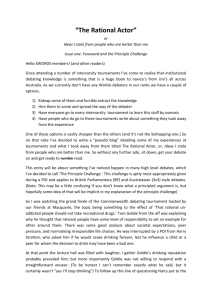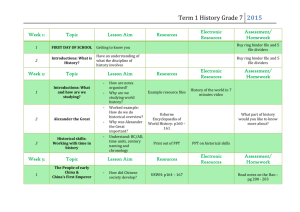Assessment Guide
advertisement

Unit Standard 13367 Version 5 Demonstrate knowledge and skills of poi Level 2 Credits 7 Assessor booklet New Zealand Qualifications Authority 2016 Unit Standard 13367 Version 5 – Demonstrate knowledge and skills of poi Level 2 Credits 7 Assessor information This unit standard can be awarded with Paetae/Achievement, Kaiaka/Merit and Kairangi/Excellence grades. Assessment criteria Paetae/Achievement Achievement with Kaiaka/Merit Achievement with Kairangi/Excellence Demonstrate knowledge of poi, and the essential skills of poi. Demonstrate in-depth knowledge of poi, and the essential skills of poi with purpose. Demonstrate comprehensive knowledge of poi, and the essential skills of poi with artistic expression. There are THREE (3) assessment tasks that the ākonga must correctly complete to gain credits for this standard. Once the ākonga has correctly completed the tasks, the assessor must complete the assessment schedule for each ākonga. Please remember that the focus is Māori performance! Nō reira: the most effective activities for assessment will be those that are practical or performance based written tests should be discouraged assessments can occur in a range of contexts, e.g. marae, school, classroom, practices or other learning contexts kapa haka competitions can be used to assess Outcome 2 of this unit standard local haka exponents and/or experts may be used to assess ākonga. Ākonga assessment booklet The ākonga receives this. It outlines important information for the ākonga including: assessment and other information assessment tasks. Ākonga assessment task sheets These sheets and any other evidence should be collected by the assessor and retained for assessment and moderation purposes. Where ākonga choose to provide oral description/evidence for Task 1 and/or Task 2 (Outcome 1), this must be recorded. Where ākonga work has been selected for moderation, the recorded evidence must be included with the materials. Page 2 of 12 New Zealand Qualifications Authority 2016 Unit Standard 13367 Version 5 – Demonstrate knowledge and skills of poi Level 2 Credits 7 You will need to discuss with the ākonga the length of time they have to complete the assessment. He ture-a-kōnui: one credit equates to 10 notional hours of teaching and assessment. Evidence of Task 3 (Outcome 2) must be recorded. Where ākonga work has been selected for moderation, the recorded evidence must be included with the materials. Where recorded evidence is submitted for moderation, ākonga identification sheet (refer following link): http://www.nzqa.govt.nz/qualificationsstandards/qualifications/ncea/subjects/preparing-digital-visual-submissions-formoderation/ must be included. Authenticity As per NZQA requirements: you must verify that the work submitted for assessment has been produced by the ākonga you must consider (and manage) the potential for work to have been copied, borrowed from another ākonga, photocopied from a book or downloaded from the internet. It is okay for ākonga to work with and learn from others to gather information from a variety of sources. However, you must be clear that the work to be assessed has been processed and produced by the ākonga. To help manage authenticity of ākonga work, where the ākonga is asked to complete any written tasks, the ākonga is asked to use their own words as well as provide reference/s for their information. Please ensure you discuss this with your ākonga. For further information, please refer to the following link: http://www.nzqa.govt.nz/providers-partners/assessment-and-moderation/assessmentof-standards/generic-resources/authenticity/ Referencing This assessment requires the ākonga the reference his/her information. For the purposes of this assessment, the following are examples of reference styles. However, you may want to change the style. Examples of referencing: Book: Author last name, Initial. (Year book was published), Name of Book, Publication City, Country: Publisher. e.g. Pōtiki, M. (1995) Haka Mana Para Tawa Ngāwhā. Kaitaia, New Zealand: Kauae Runga Publishers. Webpages: reference the homepage. e.g. http://www.hakamanaparatawangawha.co.nz Page 3 of 12 New Zealand Qualifications Authority 2016 Unit Standard 13367 Version 5 – Demonstrate knowledge and skills of poi Level 2 Credits 7 Course hand out/Lecture notes: Lecturer/Teacher last name, Initial. (Year of course/lecture). Course title: [PowerPoint Slides]/[Video]/[Lecture notes]. City, Country: Venue. e.g. Knowles, B. (2012). MPA class: [Te Wakahuia Video]. Piopiotahi, New Zealand: Piopiotahi College. Preparation for moderation Form 1 Attached for moderation* Moderation cover sheet. This should include the ākonga identifier and grades. Secondary refer following link: http://www.nzqa.govt.nz/assets/Providers-and-partners/Assessmentand-moderation/sec-mod-cvrsheet-random.doc Tertiary refer following link: http://www.nzqa.govt.nz/assets/Providers-and-partners/Assessmentand-moderation/Tertiary-Moderation/Tertiary-moderation-coversheet.doc 2 Copy of unit standard. Please ensure the version of the standard reflects the version used in the assessment task. 3 Blank copy of assessment task and assessment schedule. 4 Copy of ākonga samples (completed assessment tasks). 5 Standards with Kaiaka/Merit and Kairangi/Excellence grades, submit EIGHT samples of ākonga work. Visual/digital evidence cover sheet: http://www.nzqa.govt.nz/assets/Providers-and-partners/Assessmentand-moderation/mod-visevidence-cvr.doc Please remember: you cannot send Blueray discs, Hi8, DV or MiniDV tapes, or HD files for moderation. Remember to test the recording device to ensure that it can be read in another device. Please refer following link for further information: http://www.nzqa.govt.nz/qualificationsstandards/qualifications/ncea/subjects/preparing-digital-visualsubmissions-for-moderation/ TIP: You should start preparing the materials for moderation at least one month before the submission date. This will give you time to locate all the relevant and necessary forms and sheets. If you have any issues with preparing materials for moderation OR do not have materials to submit (i.e. you didn’t assess this standard), SPEAK to your Principal Nominee (PN) or Moderation Liaison (ML). Page 4 of 12 New Zealand Qualifications Authority 2016 Unit Standard 13367 Version 5 – Demonstrate knowledge and skills of poi Level 2 Credits 7 Assessor information – assessment tasks Outcome 1 Demonstrate knowledge of poi Assessment Task 1 – Categories Describe/explain different categories of poi. The categories of poi are – single short poi, double short poi, single long poi, double long poi. The information must be in ākonga’s own words and references must be provided. This task assesses the evidence requirements of 1.1. 1.1 Poi are described in terms of their categories. Sample answer that would be acceptable ‘Kairangi/Excellence’. 1 Single short poi Single short poi – Poi originates from the indigenous Māori people of New Zealand, and the word 'Poi' simply means ball. It refers to both a style of performing arts and the equipment used to engage in the performance. Poi are shaped into around ‘balls’ and stuffed with a variety of material such as the down of raupo, cloth, crumbled paper or fibre and covered with a variety of covers – raupo, cloth, canvas and plastic. The poi is attached to strings of varying lengths and swung rhythmically and geometrically to display a wide range of skill and beauty. Originally the poi was manipulated, basically to keep hands flexible for weaving. The poi handle or string will either be short or long and used singularly or in pairs. Poi come in two forms: short, with strings equal to the length of the fingertips to the wrist; and long, with strings equal to the distance from fingertips to shoulder.[4][5] However may kapahaka groups in modern times prefer to use a longer short poi, with string equal to the length of the finger tips to midway between the wrist and the elbow. Māori men used Poi to increase flexibility and strength in their hands and arms, to improve the balance, dexterity and co-ordination required during battle. To train fighting warriors, bags called kii were filled with a large stone and swung around to make the arms and wrists supple and strong and to test reactions. The kii bags were made of flax with short ropes but when the warriors and boys trained with them they would put on extra lengths of rope. Another variety of poi is poi tāniko. In this construction, the outer shell was made of finely woven muka using a pattern based on a fishing net; these poi sometimes included strands that were dyed yellow to form a diamond pattern known as Te Karu ō te Atua (the Eye of God). Traditional raupō poi are less likely to be used by modern poi artists since traditional materials wear quickly with frequent use. Also, flax and raupō are becoming increasingly difficult to find as the wetlands where they are naturally found have been drained or made into conservation reserves (although traditional harvesting is, generally, allowed by law). Page 5 of 12 New Zealand Qualifications Authority 2016 Unit Standard 13367 Version 5 – Demonstrate knowledge and skills of poi Level 2 Credits 7 Today, most performance poi are made from durable and readily available modern materials. Cores are often made of foam or crumpled paper, while skins consist of plastic or loomed fabrics, such as tulle. Tassels are usually made of wool. http://en.wikipedia.org/wiki/Poi_(performance_art) http://www.poipoi.info/About-Poi/History-of-Poi.htm http://nzetc.victoria.ac.nz/tm/scholarly/tei-BesGame-t1-body-d4-d1d8.html NB: your ākonga has been asked to provide references. Where you have referred to a book, or website, or person, please acknowledge this in your lessons. Assessment Task 2 – Tikanga and pūtake Describe/explain the tikanga and pūtake for TWO poi items, each from different categories. The categories of poi are – single short poi, double short poi, single long poi, double long poi. The information must be in the ākonga’s own words and references must be provided. This task assesses the evidence requirements of 1.2. 1.2 Poi are described in terms of tikanga and pūtake. Sample answer that would be acceptable for ‘Kaiaka/Merit. Poi one Name Pākete Whero Category Single Short Poi Composer name Ihapera (Isabella) Thom (Guide Bella Papakura) Composer iwi Tūhourangi Date poi was composed Early 1900’s Why poi was composed. This poi action song has been famous at Whakarewarewa since the early 1900s. The composer is said to have composed this song in honour of a man from Ruatāhuna that she was secretly having an affair with. (Paringatai, 2004) Throughout the song there are hints of their secret love e.g. meeting places – Hinemoa Street lakeside reserve; the wearing of the red scarves by both of them; Tarapounamu - a mountain peak east of Ruatāhuna, the home of Bella's lover. Page 6 of 12 New Zealand Qualifications Authority 2016 Unit Standard 13367 Version 5 – Demonstrate knowledge and skills of poi Level 2 Credits 7 Tarapounamu / tara pounamu "Tara" has several meanings: it can be a spike or spear tip, and thus it is used as a colloquial term for the penis. "Tara" also describes the side walls between two houses, and so it is sometimes used as a term for the vagina. "Tatau pounamu," a door of greenstone, is a metaphor for enduring peace. Greenstone carvings were beautiful and everlasting and were exchanged as symbols of peace. So by using a variant of this phrase, "tara pounamu," a sexual organ of greenstone, Bella describes the feeling of utter peace she experienced after she and her lover gifted their sexuality to each other. Bella was noted to be fascinated with horse racing and the sounds of galloping hooves was incorporated into the poi as a fast beat. Pākete whero Ma-u mai a koe Mā-ku e here Ka tino pai rawa e The red scarf you are wearing matches mine. How totally delightful! In 1905, guides in the Rotorua thermal area wore red headscarves. Bella's lover wore a red kerchief round his neck. Hoatu koe kei mua Hinemoa Tīriti Ko au kei muri Kei mātauria You go in front down Hinemoa Street I walk along behind lest our secret becomes known. Hinemoa Street led to a lakeside reserve with secluded places where lovers could meet He rau koikoi Tō whārikiriki He rau toromiro Tō pēra o runga e Soft pink fern leaves are your bed-mat and miro leaves your pillow. Your ascent Tō pikitanga brings an explosion of light. Taumata te Rāiti. Your descent Tō heketanga brings peaceful intimacy Ko tara pounamu e REF: http://folksong.org.nz/pakete_whero/index.htm Koi-koi, a tiny soft swamp fern (Blechnum minus). Miro, an evergreen coniferous tree (Prumnopitys ferruginea). A description of their lovemaking Page 7 of 12 New Zealand Qualifications Authority 2016 Unit Standard 13367 Version 5 – Demonstrate knowledge and skills of poi Level 2 Credits 7 Outcome 2 Demonstrate the essential skills of poi Assessment Task 3 – Demonstration Perform TWO poi items, each from different categories. The categories of poi are – single short poi, double short poi, single long poi, double long poi. This task assesses the evidence requirements of 2.1. 2.1 Appropriate body movement and voice, and correct pronunciation are demonstrated in accordance with iwi tradition, and/or the pūtake of the poi. I te ākonga e poi ana: mō Paetae/Achieved, me: matatau ia ki ngā kupu tika te mita o tōna reo, tōna whakahua i ngā kupu, me tōna hā tika tōna whai i te rangi hāngai tōna tū, me te kori i tōna tinana/mahi-ā-ringa, ki te/ngā tikanga me te pūtake o te poi. mō Kaiaka/Merit, me: mau ki te tangi me te wairua o te rangi hāngai te kori o tōna tinana ki te wairua me ngā kupu o te poi, ā, kia tika tōna tū. mō Kairangi/Excellence, me: tika te whakaputa i te wairua o te rangi, mai i te tīmatanga ki te whakamutunga tika te whakaputa i te wairua o tōna tinana me ngā kupu o te poi, mai i te tīmatanga ki te whakamutunga. Tērā ētahi wā, ka hapa te ākonga. A checklist for this task has been provided for you on the following page. This may help when you complete the assessment schedule. Please ensure one checklist is used per poi. You will need to photocopy extra copies of the checklist. Page 8 of 12 New Zealand Qualifications Authority 2016 Unit Standard 13367 Version 5 – Demonstrate knowledge and skills of poi Level 2 Credits 7 Outcome 2 – Assessor checklist: Ākonga performance Ākonga Poi item Date Requirements Performance criteria Category (please tick) Tick relevant box. single short poi Kua matatau ki ngā kupu. double short poi Kua tika te mita o te reo, te whakahua i ngā kupu, me te hā. single long poi Kua tika te whai i te rangi. double long poi Kua hāngai te tū, me te kori i te tinana/mahi-ā-ringa ki te/ngā tikanga me te pūtake o te poi. Poi item is performed. Tutor comments Paetae/Achieved Kua mau ki te tangi me te wairua o te rangi. Kua hāngai te kori o te tinana ki te wairua me ngā kupu o te poi, ā, kia tika te tū. Kaiaka/Merit Kua tika te whakaputa i te wairua o te rangi, mai i te tīmatanga ki te whakamutunga. Kua tika te whakaputa i te wairua o te tinana me ngā kupu o te poi, mai i te tīmatanga ki te whakamutunga. Kairangi/Excellence Page 9 of 12 New Zealand Qualifications Authority 2016 Unit Standard 13367 Version 5 – Demonstrate knowledge and skills of poi Level 2 Credits 7 Assessment Schedule Task 1 – Describe/explain different categories of poi. Evidence for Paetae/Achievement Evidence for Achievement with Kaiaka/Merit It is expected that ākonga samples will vary, according to iwi traditions. However, the following components should be included in the ākonga responses: As per Paetae/Achievement, plus: Evidence for Achievement with Kairangi/Excellence As per Kaiaka/Merit, plus: has identified composers from different poi categories. Please tick: linked the meaning and purpose of different poi categories. the choice of words the use of language devices to convey specific purposes and composition style is specific to the category of poi. Judgement for Paetae/Achieved Grade Judgement for Kaiaka/Merit Judgement for Kairangi/Excellence FOUR categories of poi are correctly described/explained. Poi are from different categories. Reference/s is/are provided. N A M E Examples of referencing: Book: Pōtiki, M. (1995) Haka Mana Para Tawa Ngāwhā. Kaitaia, New Zealand: Kauae Runga Publishers. Webpage: http://www.hakamanaparatawangawha.co.nz Course hand out/Lecture notes: Knowles, B. (2012). MPA class: [Te Wakahuia Video]. Piopiotahi, New Zealand: Piopiotahi College Page 10 of 12 New Zealand Qualifications Authority 2016 Unit Standard 13367 Version 5 – Demonstrate knowledge and skills of poi Level 2 Credits 7 Task 2 – Describe/explain the tikanga and pūtake for TWO poi items, each from different categories. Evidence for Paetae/Achievement Evidence for Achievement with Kaiaka/Merit Evidence for Achievement with Kairangi/Excellence Grade It is expected that ākonga samples will vary, according to iwi traditions. However, the following components should be included in the ākonga responses: the category matches the poi the name of the composer is identified, and his/her iwi is/are identified the name of the poi is identified when and why the poi was composed the words and translation of the poi values, and Māori world view. As per Paetae/Achievement, plus: As per Kaiaka/Merit, plus: Please tick: Judgement for Paetae/Achieved Judgement for Kaiaka/Merit has identified the background kōrero to the composition of each poi. has identified any personal (to the composer), social, or historical influences that led to the development of the poi composition. N A M Judgement for Kairangi/Excellence E The tikanga and pūtake of TWO poi are correctly described/explained Each poi is from different categories. Reference/s is/are provided. Examples of referencing: Book: Pōtiki, M. (1995) Haka Mana Para Tawa Ngāwhā. Kaitaia, New Zealand: Kauae Runga Publishers. Webpage: http://www.hakamanaparatawangawha.co.nz Course hand out/Lecture notes: Knowles, B. (2012). MPA class: [Te Wakahuia Video]. Piopiotahi, New Zealand: Piopiotahi College . Page 11 of 12 New Zealand Qualifications Authority 2016 Unit Standard 13367 Version 5 – Demonstrate knowledge and skills of poi Level 2 Credits 7 Task 3 – Perform two POI items, each from different categories. Evidence for Paetae/Achievement Evidence for Achievement with Kaiaka/Merit Ka whakaatu te ākonga: kua matatau ki ngā kupu kua tika te mita o te reo, te whakahua i ngā kupu me te hā kua tika te whai i te rangi kua hāngai te tū, me te kori i te tinana/mahiā-ringa ki te/ngā tikanga me te pūtake o te poi. As per Paetae/Achievement, plus: Judgement for Paetae/Achieved Judgement for Kaiaka/Merit TWO poi items are performed Poi items are from different categories. Pūtake is in accordance with iwi tradition. Pronunciation is correct. Voice and body movement is appropriate. Overall grade (please circle) kua mau ki te tangi me te wairua o te rangi kua hāngai te kori o te tinana ki te wairua me ngā kupu o te poi, ā, kia tika te tū. N (Not Achieved) A (Paetae/Achieved) Ākonga name Assessor name Ākonga signature Assessor signature Evidence for Achievement with Kairangi/Excellence As per Kaiaka/Merit, plus: Grade kua tika te whakaputa i te wairua o te rangi, mai i te tīmatanga ki te whakamutunga kua tika te whakaputa i te wairua o te tinana me ngā kupu o te poi, mai i te tīmatanga ki te whakamutunga. Judgement for Kairangi/Excellence Please tick: N A M E M (Kaiaka/Merit) E (Kairangi/Excellence) Completion date Page 12 of 12 New Zealand Qualifications Authority 2016







